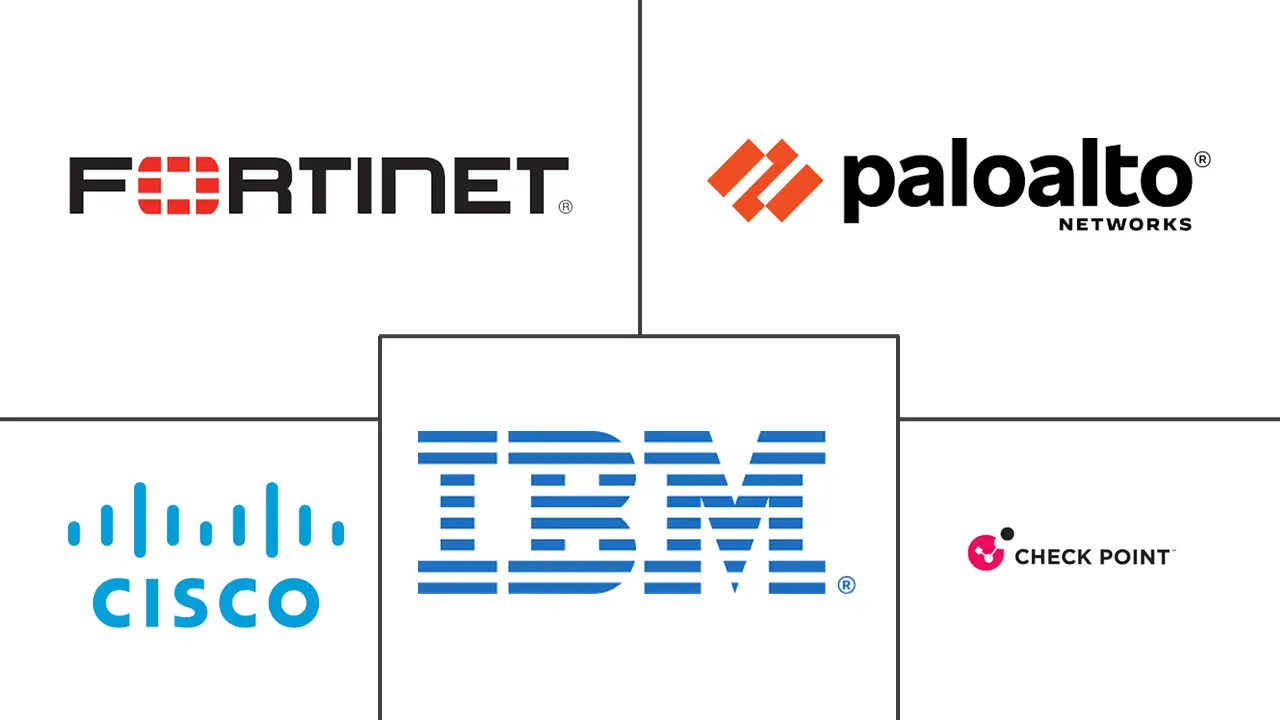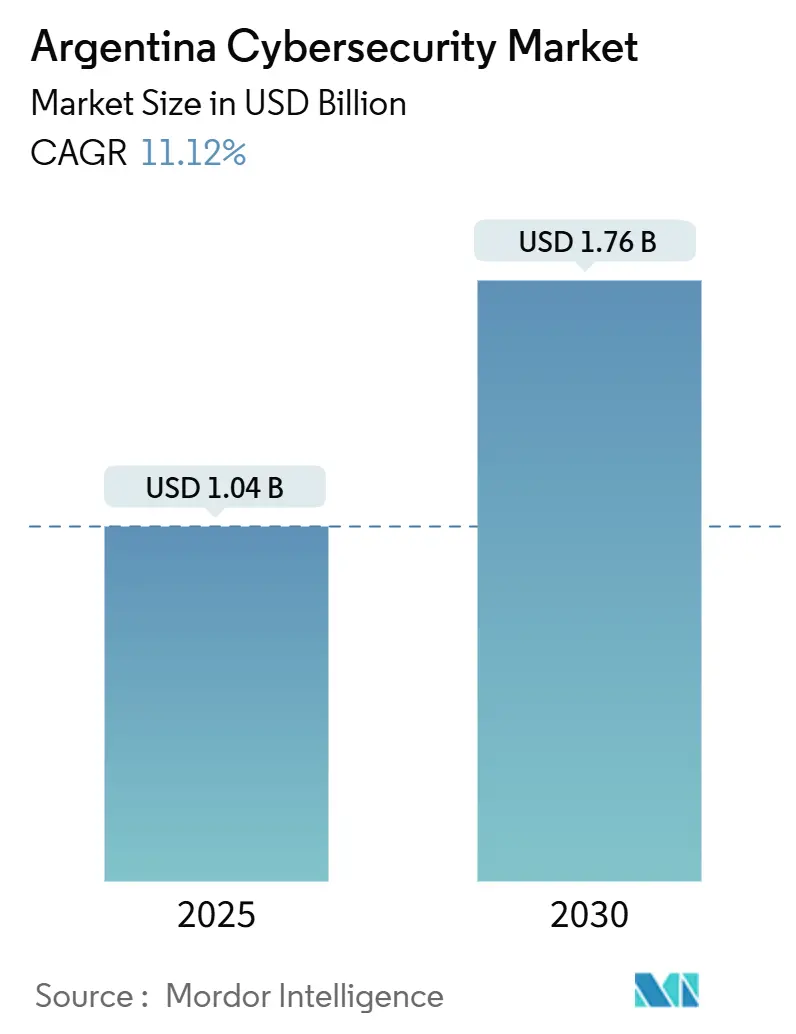
Argentina Cybersecurity Market Analysis by Mordor Intelligence
Argentina cybersecurity market is currently valued at USD 1.04 billion in 2025 and is projected to reach USD 1.76 billion in 2030, advancing at an 11.12% CAGR. Heightened digital transformation, large-scale 5G roll-outs, and rising cybercrime drive sustained spending across all verticals. The federal government’s Artificial Intelligence Unit Applied to Security predicts and prevents cyber threats, while spectrum auctions worth USD 875 million accelerate network build-outs that widen the attack surface. Cloud migration, zero-trust adoption, and the steady shift toward managed security services elevate long-term demand, although peso volatility and talent scarcity remain material headwinds. Large global vendors continue to expand, yet local specialists gain share by bundling vertical-specific compliance support and Spanish-language SOC services.
Key Report Takeaways
- By offering, Solutions led with 65.9% revenue share in 2024; Services post the fastest 12.3% CAGR through 2030.
- By deployment, Cloud commands 67.3% of Argentina cybersecurity market share in 2024, while cloud solutions rise at 13.7% CAGR through 2030.
- By organization size, Large enterprises held 72.3% share of the Argentina cybersecurity market size in 2024; SMEs are advancing at a 12.7% CAGR to 2030.
- By end user, BFSI led with 28.9% of the Argentina cybersecurity market share in 2024; Healthcare is the fastest-growing vertical at an 11.5% CAGR.
Argentina Cybersecurity Market Trends and Insights
Drivers Impact Analysis
| Driver | (~) % Impact on CAGR Forecast | Geographic Relevance | Impact Timeline |
|---|---|---|---|
| Digital transformation and cloud adoption | +2.8% | National, strongest in Buenos Aires and Córdoba | Medium term (2-4 years) |
| Escalating fintech and e-commerce cyber-threats | +2.1% | National, with spillover to regional financial hubs | Short term (≤ 2 years) |
| Government cyber regulations and 2023 National Strategy | +1.9% | National, with provincial variations | Long term (≥ 4 years) |
| 5G and IoT expansion enlarging attack surface | +1.7% | Urban centers and secondary cities | Medium term (2-4 years) |
| e-Government digital-ID push boosting IAM spend | +1.4% | National, early adoption in Buenos Aires and Mendoza | Medium term (2-4 years) |
| Patagonia data-center build-out driving SOC-aaS | +1.3% | Patagonia region | Long term (≥ 4 years) |
| Source: Mordor Intelligence | |||
Digital Transformation and Cloud Adoption
Rapid cloud migration shifts protection models from perimeter defenses to zero-trust. The QuarkID blockchain digital ID, rolled out for 2.5 million citizens, demands advanced identity and access management. Retailer Grupo Dabra cut connectivity costs by 75% and tightened security across 114 stores through an integrated platform.[1]Fortinet, "Grupo Dabra | Fortinet Case Study," fortinet.com Enterprises lacking internal know-how outsource to managed security providers, expanding the addressable base beyond traditional large corporates. As a result, the Argentina cybersecurity market benefits from cloud-first SMEs that now adopt security-as-a-service instead of hardware.
Escalating Fintech and E-commerce Cyber-threats
More than 200 fintechs growing 35% annually expose lucrative targets, pushing banks, wallets, and exchanges to harden defenses. MercadoLibre’s move into digital banking relies on zero-trust frameworks that validate every session. A 2024 registry for virtual-asset service providers imposes strict controls on crypto exchanges, enlarging compliance-driven spending. High-profile ransomware incidents at regulators and banks underscore the urgency, keeping security investment ahead of revenue growth.
Government Cyber Regulations and 2023 National Strategy
Federal Decree 615/2024 unified cyber defense under the new agency and ratified the Budapest Convention. Sectoral rules mandate encryption in finance and critical-infrastructure protection in energy and transport, making cybersecurity a non-negotiable operating cost. Fragmented provincial codes add complexity, opening space for legal-tech firms that map overlapping obligations.[2]U.S Chamber of Commerce," International Cyberlaw Project," uschamber.com These measures create steady, regulation-anchored demand in the Argentina cybersecurity market.
5G and IoT Expansion Enlarging Attack Surface
USD 875 million in 5G spectrum awards to Telefónica, Telecom, and Claro fuels nationwide roll-outs, yet 5G networks exhibit triple the cyberattack volume of 4G. Three-quarters of connected IoT devices show vulnerabilities, compelling operators to embed security-by-design. Industrial sites linking operational-technology assets through 5G now face internet-scale threats, raising long-term security outlays for manufacturing and energy clients.
Restraints Impact Analysis
| Restraint | (~) % Impact on CAGR Forecast | Geographic Relevance | Impact Timeline |
|---|---|---|---|
| Cyber-skills shortage | -1.8% | National, acute outside Buenos Aires | Long term (≥ 4 years) |
| SME budget limitations | -1.5% | Nationwide, stronger in interior provinces | Short term (≤ 2 years) |
| Peso volatility curbing hardware imports | -1.2% | Nationwide | Short term (≤ 2 years) |
| Provincial standards fragmentation | -0.9% | Nationwide | Medium term (2-4 years) |
| Source: Mordor Intelligence | |||
Cyber-skills Shortage
Although local universities graduate 27,000 tech students yearly, specialized security talent remains scarce. Entry-level analysts earn ARS 617,000 (USD 2,470) and can double salaries within a few years, pressuring budgets. Multinationals absorb much of the skilled pool, forcing SMEs to rely on managed services and automation rather than in-house teams.
SME Budget Limitations
SMEs lose USD 93,000 to USD 155,000 per breach yet still underinvest. Fifty-six percent plan to raise budgets, but devaluation and inflation dilute purchasing power. Many lack formal security policies and are unaware of tax incentives under Law 27,506, limiting near-term penetration even as cloud-based packages lower entry barriers.
Segment Analysis
By Offering: Services Accelerate Despite Solutions Dominance
Solutions contributed 65.9% revenue in 2024, backed by network, endpoint, and cloud security platforms that form baseline defenses. However, Services are set to grow at 12.3% CAGR to 2030. Professional consulting tackles risk assessments and compliance, while managed SOC offerings provide around-the-clock monitoring. Bloka’s pay-as-you-go model illustrates how SMEs obtain enterprise-grade coverage without capital expenditure.
Strong Application and Cloud Security demand sustains Solutions growth, yet point products lose ground to unified platforms. Identity management accelerates on e-government schemes, and infrastructure security becomes indispensable for critical sectors. Service-led recurring revenue stabilizes vendor cash flows, reinforcing its strategic importance in the Argentina cybersecurity market.
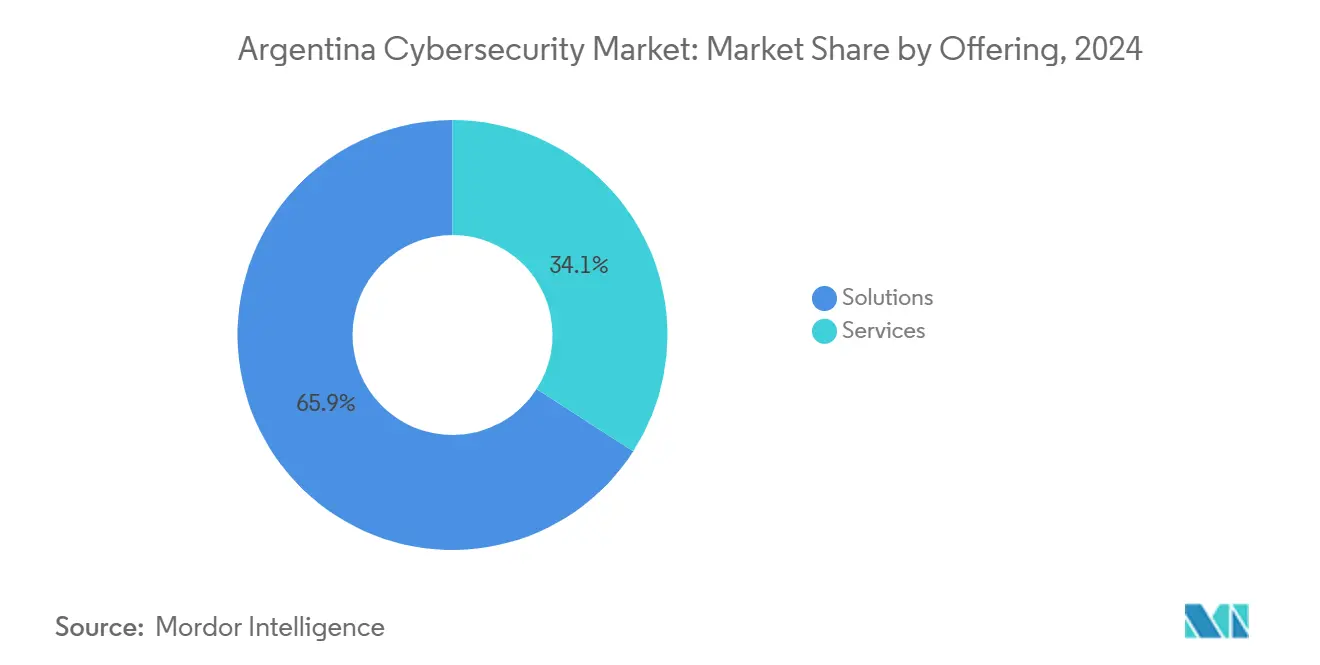
By Deployment Mode: Cloud Dominance Accelerates
Cloud deployments controlled 67.3% of 2024 revenues and will compound at 13.7% CAGR. Subscription pricing shields buyers from currency risk and eliminates lump-sum hardware imports. Automatic patching and global threat-intelligence feeds keep defenses current, suiting firms with scarce specialists.
On-premise estates persist in banking and regulated utilities due to data sovereignty. Hybrid models prevail, marrying local processing with cloud analytics. Edge architectures arising from 5G route latency-sensitive tasks locally while preserving centralized policy control, broadening deployment choices within the Argentina cybersecurity market.
By Organization Size: SME Growth Outpaces Enterprise Stability
Large enterprises kept 72.3% share in 2024, deploying advanced analytics and zero-trust frameworks. Ternium contained sophisticated attacks without material impact by reinforcing internal controls. Yet SMEs expand fastest at 12.7% CAGR, enabled by cloud suites and local integrators such as Nextware that bundle security with IT infrastructure.
SMEs gravitate toward managed detection and response, translating limited staff into outsourced expertise. Global vendors localize offerings, while Argentine specialists craft cost-controlled bundles, expanding total addressable spending inside the Argentina cybersecurity market.
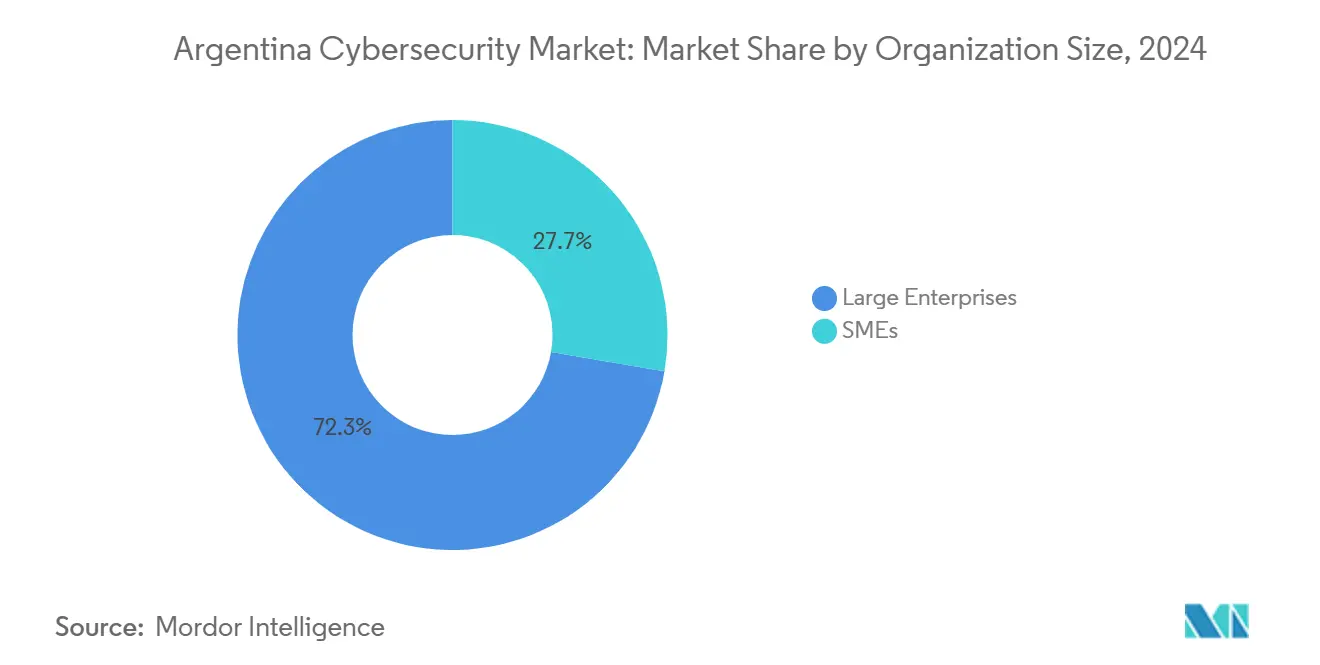
By End User: BFSI Leadership Amid Healthcare Acceleration
BFSI verticals held 28.9% revenue share in 2024, shaped by encryption mandates and high-value data. Healthcare, advancing 11.5% CAGR, digitizes records and telemedicine platforms while facing record ransomware payouts. Compliance-driven spending expands in energy, utilities, and manufacturing as connected OT increases risk exposure. Retail secures omnichannel payments and fraud prevention, reflecting the breadth of demand supporting the Argentina cybersecurity market size across industries.
Geography Analysis
Buenos Aires remains the core hub, hosting federal regulators, Fortune 500 subsidiaries, and the largest talent pools. The municipal Cybersecurity Center coordinates incident response and public education, cementing leadership in spend and innovation. High 5G coverage and major cloud-region roll-outs compound attack surfaces, prompting enterprises to elevate budgets.
Córdoba, Rosario, and Mendoza diversify market activity with technology clusters and manufacturing bases that require OT security solutions. Regional universities supply graduates, though many migrate to the capital, reinforcing skills imbalances. Provincial e-government projects open niche opportunities for vendors adept at navigating distinct procedural codes.
Patagonia emerges as a frontier growth corridor. Data-center builds and nuclear-powered AI infrastructure attract SOC-as-a-service operators seeking latency advantages and renewable energy. Limited fiber backhaul and sparse talent slow immediate scale, but joint ventures with local providers position the Argentina cybersecurity market for long-term southern expansion.
Competitive Landscape
The market is moderately fragmented. Global providers such as Fortinet, Cisco, and IBM deliver broad portfolios and R&D scale. Fortinet’s FortiAI platform couples AI detection with unified management, easing the talent deficit. Local players—NextVision, BGH Tech Partner, Telefónica Tech Argentina—leverage regulatory fluency and Spanish support to win regulated or mid-market deals.
Partnerships raise competitive stakes. BlueVoyant and Logicalis launched Spanish SOC services, while Fortinet collaborates with regional integrators to widen Unified SASE reach. Venture firms like Forgepoint Capital hunt local startups, signaling funding momentum. Vertical specialists target healthcare and manufacturing niches where compliance hurdles deter generalists, extending diversity in the Argentina cybersecurity market.
Argentina Cybersecurity Industry Leaders
-
Cisco Systems Inc.
-
Fortinet Inc.
-
IBM Corporation
-
Check Point Software Technologies Ltd.
-
Palo Alto Networks Inc.
- *Disclaimer: Major Players sorted in no particular order
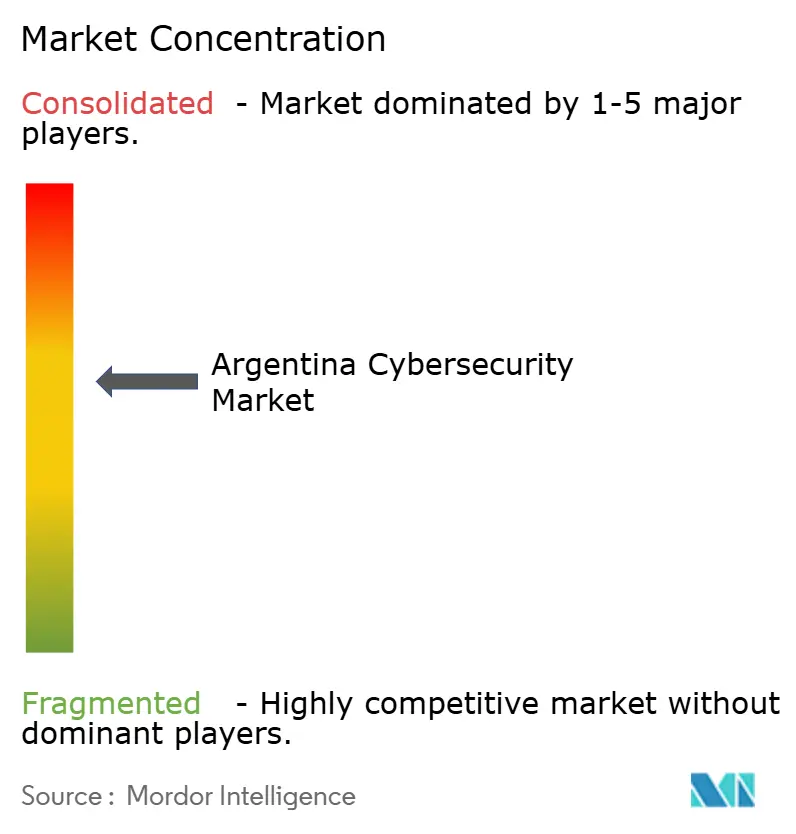
Recent Industry Developments
- March 2025: Fortinet posted USD 1.66 billion Q4 2024 revenue, up 17% YoY, driven by Unified SASE and security operations uptake in Latin America.
- February 2024: SEALSQ Corp revealed a USD 1.887 billion post-quantum cryptography push for 2029 and Latin American joint-venture plans.
- January 2025: Fortinet engaged at the World Economic Forum Annual Meeting to foster public-private cybercrime disruption.
- December 2025: Nubiral broadened cloud security and GRC services to meet rising local compliance demand.
Argentina Cybersecurity Market Report Scope
The cybersecurity market is defined based on the revenues generated from the solutions and services used in various end-user industries across Argentina.
The Argentina cybersecurity market is segmented by offerings (solutions [application security, cloud security, data security, identity access management, infrastructure protection, integrated risk management, network security, end-point security, and other solution types] and services [professional services and managed services]), by deployment (On-premise, and cloud), by organization size (SMEs, large enterprises), by end-user vertical (BFSI, healthcare, IT and telecom, industrial and defense, retail, energy and utilities, manufacturing, and other end-user industries). The market sizes and forecasts are provided in terms of value in (USD) for all the above segments.
| Solutions | Application Security |
| Cloud Security | |
| Data Security | |
| Identity and Access Management | |
| Infrastructure Protection | |
| Integrated Risk Management | |
| Network Security Equipment | |
| Endpoint Security | |
| Other Solutions | |
| Services | Professional Services |
| Managed Services |
| Cloud |
| On-Premise |
| SMEs |
| Large Enterprises |
| BFSI |
| Healthcare |
| IT and Telecom |
| Industrial and Defense |
| Retail |
| Energy and Utilities |
| Manufacturing |
| Others |
| By Offering | Solutions | Application Security |
| Cloud Security | ||
| Data Security | ||
| Identity and Access Management | ||
| Infrastructure Protection | ||
| Integrated Risk Management | ||
| Network Security Equipment | ||
| Endpoint Security | ||
| Other Solutions | ||
| Services | Professional Services | |
| Managed Services | ||
| By Deployment Mode | Cloud | |
| On-Premise | ||
| By Organization Size | SMEs | |
| Large Enterprises | ||
| By End User | BFSI | |
| Healthcare | ||
| IT and Telecom | ||
| Industrial and Defense | ||
| Retail | ||
| Energy and Utilities | ||
| Manufacturing | ||
| Others | ||
Key Questions Answered in the Report
What is the current value of the Argentina cybersecurity market?
The market is valued at USD 1,.04 billion in 2025
How fast is the market expected to grow?
It is projected to expand at an 11.12% CAGR, reaching USD 1.76 billion by 2030.
Which segment is growing the fastest?
Services, especially managed security offerings, are rising at a 12.3% CAGR.
Why are SMEs a key growth driver?
Affordable cloud-based security tools and managed services allow SMEs to access enterprise-grade protection without large capital outlays.
Page last updated on:
